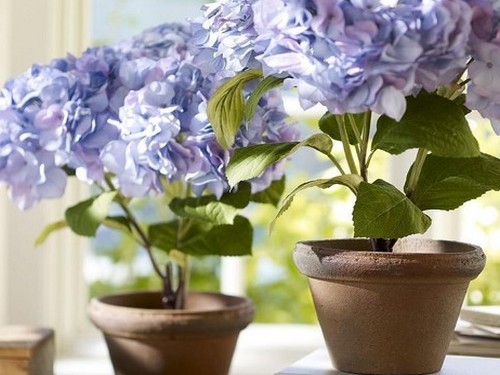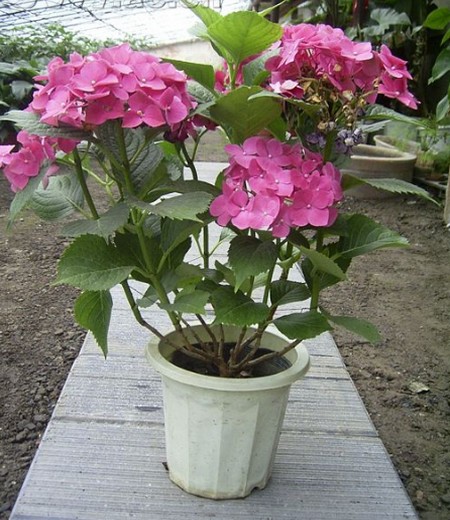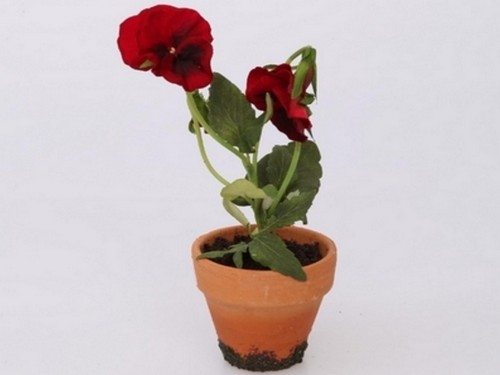How to raise potted Hydrangea / eight Immortals
Hydra macrophylla (scientific name: Hydrangea macrophylla), also known as hydrangea, purple flower, is a plant belonging to Hydra genus of Saxifraga family. Hydrangea white fullness, large and beautiful, its color can be red to blue, pleasing to the eye and God, is a common potted ornamental flowers and trees. Chinese cultivation of hydrangea time earlier, in the Ming and Qing Dynasties built in Jiangnan gardens are planted hydrangea. Parks built in the early 20th century are also inseparable from the planting of hydrangea. Modern parks and scenic areas are planted in patches to form landscapes.

It is advisable to change pots once a year in early spring, and change into new culture soil (decaying leaf soil, garden soil and a small amount of sand). Remove some old soil and rotten roots when changing pots, and prune them properly. Hydrangea like fertilizer, growth and development period, generally every half month to apply a decomposed thin liquid fertilizer, in order to make the pot soil often maintain acidity, can add 100 grams of ferrous sulfate per 50 kilograms of liquid fertilizer, irrigation. When potassium dihydrogen phosphate solution is added 1-2 times in bud stage, the flowers will be big and colorful.
Hydrangea macrophylla leaves are bigger and need more water. In addition to the low temperature in winter, to strictly control the amount of water, spring, summer, autumn watering should be sufficient, so that the pot soil often maintain a moist state, especially in summer, but also need to give sufficient moisture. From May to the end of August, it is also necessary to spray water on the leaves once a day or every other day. Because hydrangea is a fleshy root, too much water is easy to rot roots, so watering should not be excessive. Pour out the accumulated water in the basin in time after rain. After September, the weather is getting cooler, so gradually reduce the amount of watering, so that the branches grow healthy, so as to facilitate winter dormancy.
Before frost falls, move indoors, room temperature is maintained at 5℃ or so, promote its dormancy. Before winter comes, the leaves should be removed to avoid rotting. From the middle of December, it moved to the sunny place one after another, and the temperature rose to 15℃-20 ℃, which promoted the growth of branches and leaves, and came out of the room after the rain in the following year. Because hydrangea flower head is too big, should set up support in time to bind, this can keep flower plant erect, can make plant appear plump again.
Specific farming methods:
1. Soil
Hydrangea planting soil to loose, fertile and good drainage of sandy loam for good. But the color is affected by soil pH, acid soil flowers are blue, alkaline soil flowers are red.
2. Temperature
The optimum temperature for hydrangea growth is 18℃~28℃, and the winter temperature is not lower than 5℃. Flower bud differentiation needs 6~8 weeks at 5℃~7℃, 20℃ can promote flowering, maintain 16℃ after flowering, can prolong flowering period, pay attention to high temperature to make flowers fade quickly.
3. Light
Hydrangea is a short-day plant, usually cultivated to avoid the sun, 60%~70% shade is the most ideal. Appropriate shade can prolong the flowering period in summer when the light is too strong.
4. Watering
Hydrangea planting pot soil to keep wet, but watering should not be too much, especially in rainy season to pay attention to drainage, prevent waterlogging caused by rotten roots. Winter indoor potted plants to a little dry as well. Too much moisture makes the leaves decay easily.
5. Fertilization
Hydrangea flower flowering for 6~7 months, flowering period fertilizer water should be sufficient, fertilization once every half month.
6, pruning
Hydrangea flowers after flowering to pay attention to remove the stems, promote the production of new branches, appropriate pruning, can maintain the beautiful shape of the plant.
7. Pests
Hydrangea mainly has wilting disease, powdery mildew and leaf spot disease. 600 times solution of 65% Zineb WP was sprayed to control it. Insect pests have aphids and bugs harm, available 40% omethoate EC 1500 times spray kill.
Time: 2019-06-01 Click:
- Prev

Culture methods and matters needing attention of potted eight Immortals (Hydrangea)
There are a variety of breeding methods for eight Immortals (Hydrangea). Let's start with the most familiar ones. Cutting, this method is unknown to everyone, which is like inadvertently cutting willow into shade. Cut off the fresh shoots at the top and insert them into the soil at about 15 degrees in spring. The second is the strip pressing method.
- Next

How to raise potted butterfly flowers
Butterfly, also known as pansy and grimace, is one of the three main grass flowers in spring flower beds in northern China. Butterfly is native to northern Europe and is a kind of violaceae flower like the wild flower Viola in early spring in China. Nowadays, all the popular varieties are artificial hybrids. The butterfly flower was originally a perennial perennial grass flower.
Related
- Fuxing push coffee new agricultural production and marketing class: lack of small-scale processing plants
- Jujube rice field leisure farm deep ploughing Yilan for five years to create a space for organic food and play
- Nongyu Farm-A trial of organic papaya for brave women with advanced technology
- Four points for attention in the prevention and control of diseases and insect pests of edible fungi
- How to add nutrient solution to Edible Fungi
- Is there any good way to control edible fungus mites?
- Open Inoculation Technology of Edible Fungi
- Is there any clever way to use fertilizer for edible fungus in winter?
- What agents are used to kill the pathogens of edible fungi in the mushroom shed?
- Rapid drying of Edible Fungi

